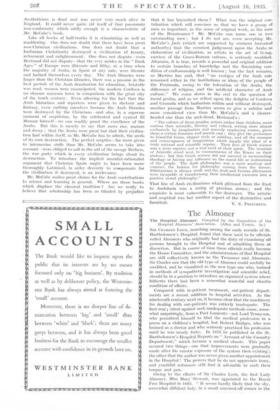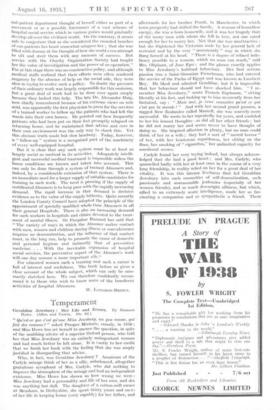The Almoner
The Hospital Almoner. Compiled by the Committee of the Hospital Almoners' Association. (Allen and Unwin. 5s.) SIR CfrAnkEs Locu, searching among the early records of St. Bartholomew's Hospital, found that there used to be officials called Almoners who originally had the duty of examining' all persons brought to the Hospital and of admitting them* at discretion. But in course of time these officials really became the House Committee, and the administrators of that Hospital Are still collectively known as the Treasurer and Almoners. Sir Charles saw that the old type of Almoner could usefully be modified, and he visualized as the new type one who, trained in• methods of sympathetic investigation and scientific relief, should be in a position to introduce an organized system where hitherto there had been a somewhat wasteful and chaotic condition of affairs.
Compared with in-patient treatment, out-patient depart- ments are a recent addition to hospital activities. As the nineteenth century went on, it became clear that the machinery for dealing with out-patients was entirely inadequate. The first real 1 rotest against such inadequate methods came, some- what surprisingly, from a Poet Laureate—not Lord Tennyson, who permitted himself to libel the medical profession in a poem on a children's hospital, but Robert Bridges, who was trained as a doctor and who seriously practised his profession until he was nearly forty. In 1876 he published in the St. Bartholomew's Hospital Reports an " Account of the Casualty .Department," which became . a medical classic. This paper ,secured two things—one that improvements were gradually made after his caustic exposure of the system then existing; the other that the author was never given another appointment in the Hospital ! The powers that be do not appreciate irony, and youthful reformers still find it advisable to curb their tongue and pen.
Owing' to the efforts of Sir Charles Loch; the first Lady Almoner, Miss Mary Stewart, was' appointed to the Royal Free Hospital in 1895. " It seeing hardly likely that the shy, somewhat diffident lady, in a Small screened-off corner in the
nut-patient department thought .of herself either as part of a movement or as a possible forerunner of a vast scherpe , of ,hospital social service which in various guises would gradually develop all over the civilized world. On the contrary, it seems „safe to conjecture that as she considered the crowded benches of out-patients her heart somewhat misgave her ; that she was ,filled with dismay at the thought oflow she could even attempt to sift and steer them with any measure of success. But service with the Charity Organization. Society had taught her the value of investigation and the power of co-operation." -For at this stage there was no constructive policy, and although :medical staffs- realized that their efforts were often rendered nugatory by the absence of help on the social side, they were WOW in trying to evolve such a policy. No doubt the pressure of their ordinary work was largely responsible for this omission, but a great deal of work had to be done over again simply because they lacked this help. The late Dr. Alexander Haig, .now chiefly remembered because of his extreme views on uric acid, was apparently the first physician to press for the services of a trained worker to follow up the patients who had left the wards into their own homes. He pointed out how frequently patients who had been put on their feet promptly relapsed on returning home, and he maintained that advice and care in their own environment was the only way to check this. Yet this obvious truth made but slow headway. Today, however,
" follow-up " system is a .recognized part of the machinery of every well-equipped hospital.
But it is clear. that any such system must be at least as largely social as medical in its activities. Adequately intelli- 'gent and successful medical treatment is impossible unless the home conditions are known and taken into account. This 'can only be done through a system of trained Alinoners and, indeed, by a considerable extension of that system. There is an immediate need for a larger supply of suitable candidates for training in such work. The need is pressing if the supply of certificated Almoners is to keep pace with the rapidly increasing 'demand. The rapid increase in that demand is decisive evidence as to the value of the supply hitherto. Quite recently the London County Council have adopted the principle of the appointment of specially qualified whole-time Almoners in all their general Hospitals. There is also an increasing demand for such workers in hospitals and clinics devoted to the treat- , ment of mental illness. Sir Farquhar Buzzard has said that " The variety of ways in which the Almoner makes contact with men, women and children during illness or convalescence yequires no denionstration, and the influence of that contact .must, in the long run, help to promote the cause of domestic and personal hygiene and indirectly that of preventive medicine. . . . With the inevitable expansion of hospital social services, the preventive aspect of the Almoner's work will one day assume a more important rdle." For educated women such a training and such a career is full of interest and usefulness. The book before us gives a clear account of the whole subject, which can only be sum- marily sketched here. We can therefore confidently recom- mend it Co those who wish to know more of the beneficent activities of hospital Almoners, W. LANGDoN-BROWN.



































 Previous page
Previous page